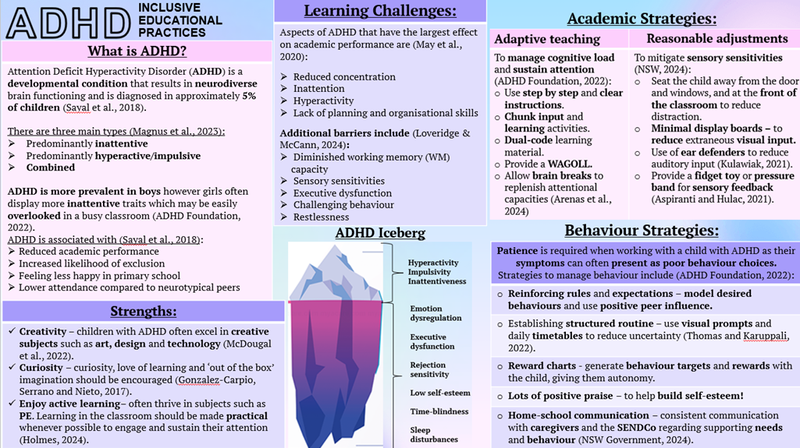ADHD: Inclusive Educational Practices
- Primary
- Education and Language
- Inclusion
- ADHD
- Neurodiversity
"The poster offers an overview of Attention Deficit Hyperactivity Disorder (ADHD), focusing on the challenges, strengths, and strategies to support children in the primary environment. I created an iceberg to illustrate that while ADHD's visible symptoms—such as inattentiveness, hyperactivity, and impulsivity—are easily recognised, many internal struggles often remain hidden. Beneath the surface, children with ADHD may face difficulties such as cognitive impairments (e.g. poor working memory and executive dysfunction), time-blindness, emotional dysregulation, rejection sensitivity, sleep disturbances, and low self-esteem (Mandriota, 2022). These challenges can hinder their learning and must be carefully considered when developing inclusive support strategies. The poster highlights several key barriers to learning both academically and behaviourally, however I will expand on some of these aspects. Academic Strategies
Reduced working memory can create barriers regarding the retention of information and impedes learning due to increased risk of cognitive overload (Langerock et al., 2025). As such, adaptive strategies that alleviate cognitive load are supportive for students with ADHD. These include breaking tasks into smaller, manageable steps (chunking), giving clear and explicit instructions, dual-coding learning material (combining visual and verbal cues) and providing a What a Good One Looks Like (WAGOLL) to reduce cognitive load by clarifying task expectations (ADHD Foundation, 2022).
Sustaining attention for extended periods can be challenging for children with ADHD. Consequently, an effective strategy to address this is incorporating brain breaks—short, structured breaks that allow children to reset and improve focus. Physical activity during these breaks can further support attention and learning (Arenas et al., 2024). Further, children with ADHD may experience hypo or hypersensitivity to sensory stimuli or may seek sensory input to self-regulate, which can hinder concentration (Shimizu et al., 2014). The poster details reasonable adjustments that can be made to accommodate these needs, however fidget toys should be deployed with teacher discretion as these can help or hinder learning depending on the child’s needs and the situation (Aspiranti & Hulac, 2021).
Behavioural Strategies
Poor behaviour choices can present challenges for children with ADHD due to heightened impulsivity and reduced self-regulation capacities (Staff et al., 2023). Therefore, effectively managing behaviour is an essential endeavour for teachers. One of the most important strategies to support behaviour is through providing consistent praise for positive behaviours and expertly withdrawing attention to limit the amount of negative attention the child receives (DuPaul et al., 2011). Research demonstrates that children with ADHD receive a disproportionate amount of negative attention relative to their neurotypical peers, resulting in negative attitudes towards school and impacting self-esteem (Zeigler, 2008). Additionally, implementing structured reward systems/charts and setting achievable behavioural targets can motivate children, give them a sense of accomplishment and enhance self-esteem, which benefits learning (Tripp, 2022). Consistent communication between the school and the child’s caregivers is also advantageous as regular updates, coupled with shared strategies for support, ensure a holistic approach to addressing the child’s needs (NSW Government, 2024).
Strengths
While ADHD presents challenges, children also possess unique strengths. They often exhibit creativity, imagination, and heightened curiosity that can foster a passion for learning (Gonzalez-Carpio et al., 2017). Teachers can leverage these strengths by encouraging the child’s inquisitive nature and helping them explore their interests through creative and hands-on activities. Children may excel in subjects that engage their creativity or physical activity, such as art, music, or physical education (McDougal et al., 2022). By incorporating these interests into wider lessons, adding creative or practical elements to the learning, teachers can keep students engaged (Holmes, 2024).
The poster demonstrates that ADHD is a multifaceted condition that requires a thoughtful, individualised approach. Unfortunately, ADHD is still conceptualised as a ‘disorder’ and is often met with a negative stigma (Mueller et al., 2012). The first step in creating an inclusive environment is to reconceptualise our attitude towards the condition. It is essential that teachers and school staff are well-informed about ADHD and adopt a growth mindset toward each child’s abilities (McDougal et al., 2022). Adopting this mindset and using a variety of inclusive strategies will allow children with ADHD to thrive at school both academically and personally. "
I have learned that inclusive education involves creating a learning environment that supports and challenges all children, removing any barriers they may face. This does not involve separating certain individuals from others, removing them to partake in different activities, but rather calls for the inclusion of all in the classroom together. I can further build on my professional understanding by remaining well-informed about evidence-based practices and adjustments made to accommodate the varied needs of a class of children, but also through consistently reflecting upon the strategies I am observing and speaking to expert professionals such as SENDCos and members of senior leadership to discuss how they ensure the school is an inclusive and supportive environment for all. As a trainee primary school teacher committed to inclusive educational practices, enhancing the impact of my teaching on each child's learning requires an equity-focused approach. This involves recognising that each student has unique needs, backgrounds, and starting points, and adapting my teaching to ensure all learners can succeed in my classroom. Providing equity of access to the curriculum requires providing differentiated support tailored to individual needs, such as scaffolding tasks, offering multiple channels of representation and engagement, and engaging in adaptive teaching strategies. By using formative assessments and ongoing feedback, I can identify barriers to learning and adjust my approach accordingly. This may include modifying resources, using ICT tools for accessibility, or incorporating culturally responsive teaching methods to make learning meaningful for all my future students.

